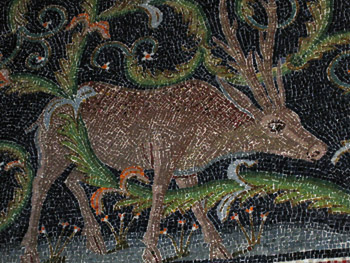 by Sarah Humphreys
by Sarah Humphreys
O lone Ravenna! Many a tale is told
Of thy great glories in the days of old:
Two thousand years have passed since thou didst see
Caesar ride forth to royal victory.
Mighty thy name when Rome’s lean eagles flew
From Britain’s isles to far Euphrates blue;
And of the peoples thou wast noble queen,
Till in the streets the Goth and Hun were seen.”
So Oscar Wilde summarized the history of Ravenna in his poem bearing the city’s name. Ravenna was capital of the Western Roman Empire, The Arian Ostrogothic Kingdom and The Byzantine Empire before becoming kingdom of The Lombards. The final resting place of Dante, was also home to Byron from 1819 to 1821, while he was involved with Teresa Guiccioli, a young married aristocrat. The crowning jewels of Ravenna can be found in her impressive collection of mosaics, which are housed in seven of her eight UNESCO World Heritage Sites. Ravenna is truly the “City of Mosaics” and many of the streets are decorated with modern mosaic designs ranging from flowers to space invaders.
No trip to Ravenna would be complete without visiting her stunning UNESCO sites, described as having “remarkable significance by virtue of the supreme artistry of the mosaic art that the monuments contain, and also because of the crucial evidence that they provide of artistic and religious relationships and contracts at an important part of European History.”
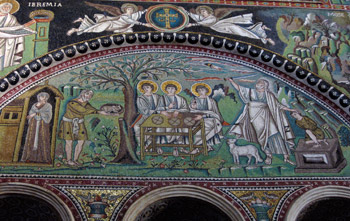 An unknown architect finished the Basilica of San Vitale in 547 on the spot where St Vitalis was martyred by being buried alive. Richly ornamented mosaics inside depict scenes from The Old Testament, including the Sacrifice of Isaac, Moses and The burning bush and Cain and Abel. Decorative leaves, fruit and flowers encircle the Lamb of God on the vault of the presbytery. Glittering mosaics pay homage to the Emperor Justinian I and his Empress Theodora.
An unknown architect finished the Basilica of San Vitale in 547 on the spot where St Vitalis was martyred by being buried alive. Richly ornamented mosaics inside depict scenes from The Old Testament, including the Sacrifice of Isaac, Moses and The burning bush and Cain and Abel. Decorative leaves, fruit and flowers encircle the Lamb of God on the vault of the presbytery. Glittering mosaics pay homage to the Emperor Justinian I and his Empress Theodora.
After straining your neck to look at the beautiful scenes on the ceiling, don’t forget to look at the floor which features simple mosaics of birds and animals, and a marble labyrinth just west of the sanctuary, which consists of 11 concentric circles and leads to a decorative scallop shell.
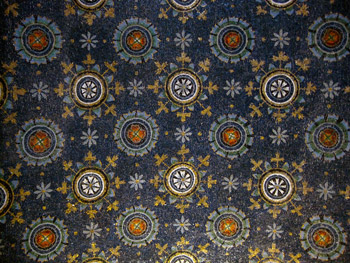 Exiting from the back of San Vitale, you will come across a small, ordinary-looking brick building, which contains Ravenna’s finest treasures. The powerful Roman Empress Galla Placidia, who wielded extreme power as regent for her young son Valentinian III, probably commissioned the tiny Mausoleum which bears her name. Shaped like a Greek cross, the building has sunk 4.5 feet into the ground due to subsidence. The limited space within the structure means visits are restricted to five minutes only, guaranteed to be intense moments.
Exiting from the back of San Vitale, you will come across a small, ordinary-looking brick building, which contains Ravenna’s finest treasures. The powerful Roman Empress Galla Placidia, who wielded extreme power as regent for her young son Valentinian III, probably commissioned the tiny Mausoleum which bears her name. Shaped like a Greek cross, the building has sunk 4.5 feet into the ground due to subsidence. The limited space within the structure means visits are restricted to five minutes only, guaranteed to be intense moments.
The entire vault is covered in ancient mosaic work dating from 430. More than 800 stars are arranged around a golden cross in a deep blue sky, which is said to have so impressed Cole Porter on his visit during his honeymoon that it inspired him to write “Night and Day.” An early depiction of Christ as The Good Shepherd shows him wearing purple robes and a golden tunic. The arches are covered in geometric patterns, which appear almost contemporary with their vivid colouring. The mausoleum contains three sarcophagi, which are attributed to Galla Placida, and the Emperors Valentinian III and Constantinus III. The largest probably contained falsified relics of Galla Placidia, supposedly in sitting position. The relics were destroyed when local boys accidently set fire to them in 1577.
 The Basilica of San Apollinare Nuovo houses a series of impressive mosaics dating from 500 under rule of the Arian King Theodoric, which show scenes of Christ’s miracles, parables and The Passion. The lower rows of mosaics date from 560, when Ravenna was under Christian rule, and feature saints, martyrs and a procession of Virgins led by The Three Magi, sporting animal-print leggings. According to legend, Pope Gregory had the earlier mosaics blackened to prevent worshippers from being distracted, and many of the original Arian mosaics were removed. It is still possible to see some disembodied limbs that evaded destruction.
The Basilica of San Apollinare Nuovo houses a series of impressive mosaics dating from 500 under rule of the Arian King Theodoric, which show scenes of Christ’s miracles, parables and The Passion. The lower rows of mosaics date from 560, when Ravenna was under Christian rule, and feature saints, martyrs and a procession of Virgins led by The Three Magi, sporting animal-print leggings. According to legend, Pope Gregory had the earlier mosaics blackened to prevent worshippers from being distracted, and many of the original Arian mosaics were removed. It is still possible to see some disembodied limbs that evaded destruction.
A fascinating contrast can be seen between the scenes depicted in the Neonian and Arian baptisteries. Although both ceiling mosaics depict the Baptism of Christ by John the Baptist, there are distinct differences between the representations of Christ. The Arian figures are far simpler and Christ is a youthful, beardless figure.
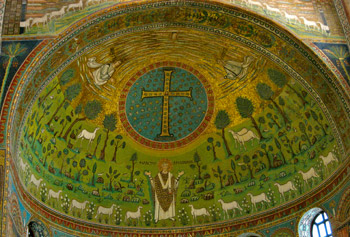 The Chapel of St Andrew, housed in the Archbishop’s museum, is the smallest private early Christian oratory to have survived until the present day. Dazzling mosaics create a shimmering tapestry of saints, angels and decorative motifs and 99 species of birds are shown against a splendid starry sky. Christ is shown as a warrior, crushing the figures of a serpent and a wild beast.
The Chapel of St Andrew, housed in the Archbishop’s museum, is the smallest private early Christian oratory to have survived until the present day. Dazzling mosaics create a shimmering tapestry of saints, angels and decorative motifs and 99 species of birds are shown against a splendid starry sky. Christ is shown as a warrior, crushing the figures of a serpent and a wild beast.
The Basilica of Sant Apollinare in Classe is situated 8km south of Ravenna and contains some of the most impressive artworks in the area. A soft green background, covering the apse, serves as backdrop to various Biblical scenes, representations of the apostles and evangelists and the figure of St Apollinare. This is the first known example of a figure other than Christ being central for the apse decoration. The majestic church also contains Early Christian sarcophagi designed for most of Ravenna’s bishops from the 5th to the 8th centuries.
 The only UNESCO World Heritage Site not to contain mosaics is the Mausoleum of Theodoric. Its unusual structure, consisting of two decagonal parts topped by a monolithic dome, is formed from Istrian stone blocks. The combination of Roman, Barbarian and Medieval architecture fascinated The Romantics and The Mausoleum was popular with tourists on The Grand Tour.
The only UNESCO World Heritage Site not to contain mosaics is the Mausoleum of Theodoric. Its unusual structure, consisting of two decagonal parts topped by a monolithic dome, is formed from Istrian stone blocks. The combination of Roman, Barbarian and Medieval architecture fascinated The Romantics and The Mausoleum was popular with tourists on The Grand Tour.
The proud tradition of mosaic making is kept alive today, using ancient Roman and Byzantine techniques, and it is well worth visiting one of the workshops were you can watch artisans at work. A wide range of souvenirs are available ranging from jewellery boxes and ornaments to re-creations of classical works and sparkling homages to rock stars such as Jimi Hendrix and The Rolling Stones.
 Other notable sites include the extraordinary underwater crypt in the cathedral of San Francesco, complete with goldfish, and the “House of Stone Carpet”, the remains of a Byzantine house complete with huge decorative floor mosaics. Just next to the Cathedral is the final resting place of Dante, who died in Ravenna in 1321. Although exiled form Florence in his lifetime, the city has continuously appealed for the great poet’s remains to be returned. Ravenna has constantly turned down this request. On the 2nd Sunday in September, olive oil donated by the city of Florence, is brought to Ravenna to light the lamb that hangs over Dante’s tomb.
Other notable sites include the extraordinary underwater crypt in the cathedral of San Francesco, complete with goldfish, and the “House of Stone Carpet”, the remains of a Byzantine house complete with huge decorative floor mosaics. Just next to the Cathedral is the final resting place of Dante, who died in Ravenna in 1321. Although exiled form Florence in his lifetime, the city has continuously appealed for the great poet’s remains to be returned. Ravenna has constantly turned down this request. On the 2nd Sunday in September, olive oil donated by the city of Florence, is brought to Ravenna to light the lamb that hangs over Dante’s tomb.
Piazza del Popolo is the real centre of Ravenna, and the perfect place to sit at a pavement café, sip a glass of wine, savour a piadina (stuffed flatbread) and watch the world go by. Every June and July the square is transformed into the backdrop for concerts in the Ravenna Festival, which features classical music, opera, jazz, dance and exhibitions.
Although the main sites in Ravenna could be seen in a day, it is well worth spending longer in this peaceful city. The place where Dante finished his “Divine Comedy” and Byron started writing “Don Juan”, was recently voted the number one place to live by “Il Sole 24 “ financial newspaper and it surely won’t take you long to see why.
If You Go:
♦ The nearest airport is Forli, which is 20km away and is served by Ryanair. Bologna airport is 80km away.
♦ Ravenna is on the main rail line to Bologna and Rimini.
♦ By car take highway A14 – Follow signs for the A14D from A14 East.
♦ The Basilica of San Vitale, Mausoleum of Galla Placidia, Basilica of Sant’ Apollinare Nuovo, Neonian Baptistery and Chapel of St Andrew can only be visited by buying a combined ticket form the ticket office in the centre of town. The Ticket costs €9.50-Reductions €8.50. The ticket is valid for seven consecutive days from the date of issue.
♦ Entrance to The Mausoleum of Theodoric costs €4, Reductions €2
♦ Tickets for the Basilica of Sant’ Apollinare in Classe cost €5, Reductions €2.50
♦ Entrance to the Arian Baptistery is free
♦ Admission times vary according to the time of year. See www.ravennamosaici.it for details.
♦ Queues for the Basilica of San Vitale and Galla Placidia can be quite long. It is best to head there early in the morning or around lunchtime.
♦ The UNESCO World Heritage Sites are all central apart from The Mausoleum of Theodoric, which is just outside the centre and the Basillica of Sant’ Apollinare in Classe, which can be reached by car or bus.
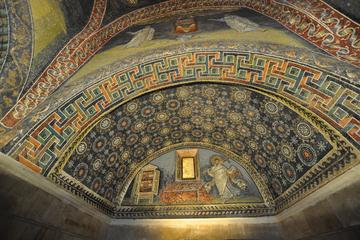
Ravenna and its Enchanting Mosaics Full-day Tour
About the author:
Sarah Humphreys is originally from near Liverpool, UK and has lived in Canada, The USA, The Czech Republic, Greece and Italy. She currently lives in Pistoia, near Florence, where she teaches English, writes freelance and is a part-time poet. She has been writing since she could hold a pencil and her passions include Literature, poetry, music and travel. Follow her on twitter: Sarah Humphreys @frizeytriton.
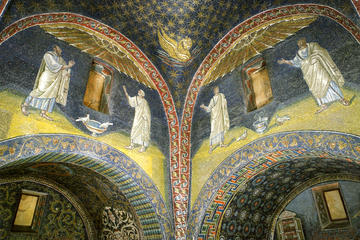
Ravenna and its Mosaics Private Tour with Piadina Tasting
All photos by Sarah Humphreys:
Detail of Mosaic in The Mausoleum of Galla Placidia
The Sacrifice of Isaac-Basilica of San Vitale
Detail of Mosaic in The Mausoleum of Galla Placidia
The Three Magi-Sant’ Apollinare Nuovo
The Apse Sant’ Apollinare in Classe
Traditional Techniques at Work
The Flooded Crypt of San Francesco



